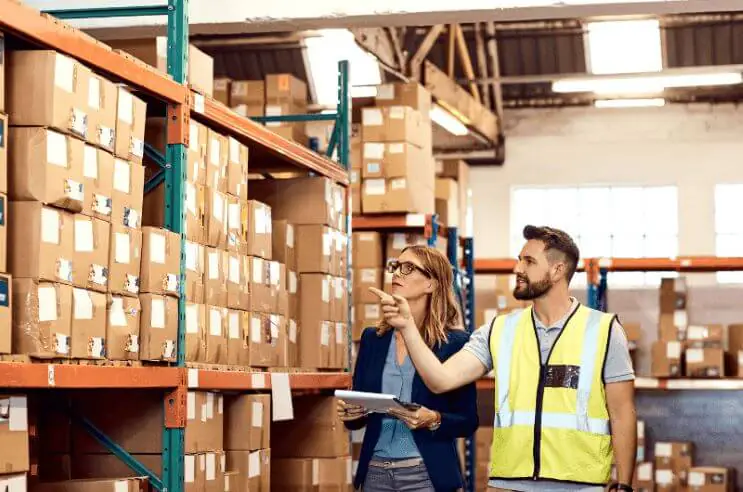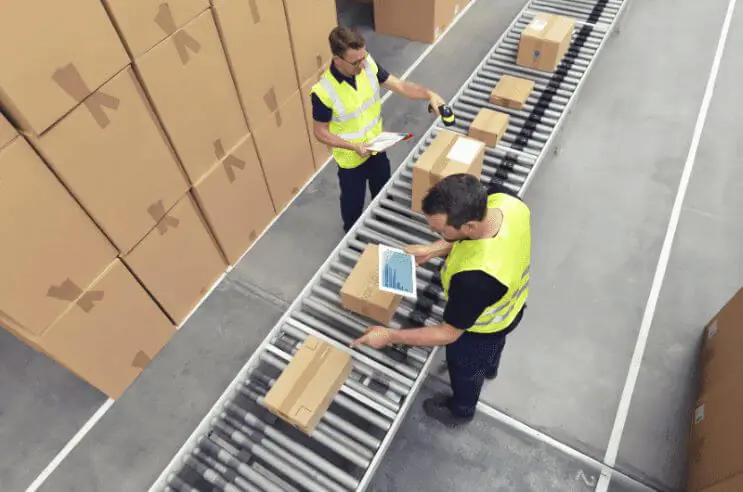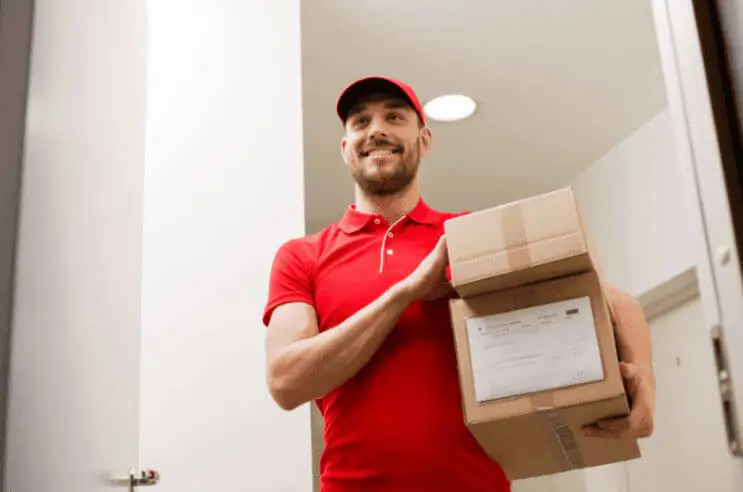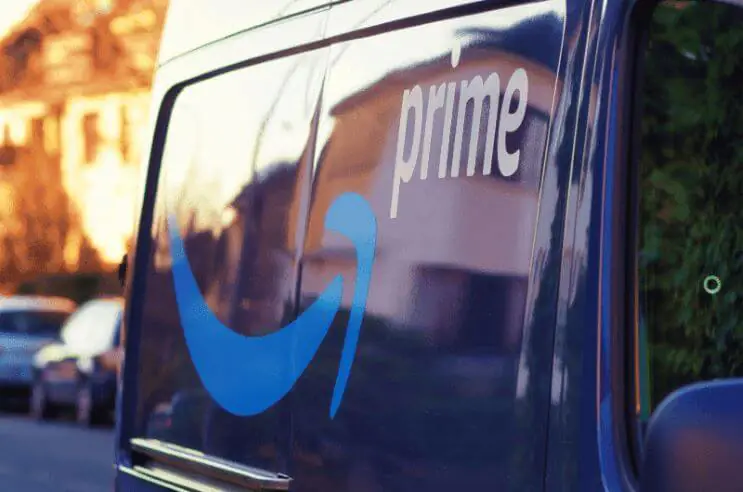90% of Customers Consider Two- to Three-day Shipping Standard: 3 Ways to Improve Your Delivery Time
E-commerce sales are predicted to surpass US $6.3 trillion globally in 2024 and these numbers will likely rise even further in the years to come. For e-commerce enterprises to succeed, logistics is essential. Logistics in e-commerce refers to a wide range of tasks such as order processing, warehousing, transportation, and inventory management. In essence, it includes everything from the time a consumer places an online order until the goods are delivered to their door.

Source: www.canva.com
What is E-commerce?
Electronic commerce, or e-commerce, is the term used to describe the buying and selling of products and services conducted online. The U.S. Census Bureau reports that in 2011, e-commerce made up about 5% of all retail sales. But when the COVID-19 epidemic struck in the second half of 2020, e-commerce took off and accounted for 16.5% of retail sales. Afterward, the trend kept rising and by 2023, it had reached 20.1%.
One of the latest trends in e-commerce is m-commerce, which stands for mobile commerce and refers to buying and selling through handheld services (e.g. phones and tablets).
By the end of 2023, smartphone usage surpassed desktop and tablet usage to account for about 80% of all retail website visits globally. This led to the bulk of online orders being placed through smartphones. It has become incredibly popular in Asia, especially in China and South Korea, where mobile devices account for more than two-thirds of all online transactions.

Source: www.canva.com
What is E-commerce Logistics?
As mentioned above, to satisfy online clients’ expectations, e-commerce logistics include organizing, carrying out, and managing the movement and storage of goods in a supply chain. Everything is coordinated, from suppliers to customers. Online businesses need effective e-commerce logistics to succeed because they have a direct impact on customer satisfaction, retention, and overall profitability.
Are Customers Loyal to a Brand?
75% of customers globally say they are loyal to at least one brand, demonstrating the increasing importance of brand affinity and loyalty when making decisions as consumers (dhl.com). How can you achieve brand-loyal customers?
The important thing is a well-managed supply chain that enables your company to meet consumer demand and prevent stockouts by ensuring that appropriate products are available when needed. But that’s not all. For satisfied customers, it’s also important to provide accurate information on the e-shop, quality customer support, various payment options, easy product return options, and much more.
By ensuring that your customers have a great experience, you may cultivate positive associations in their minds that lead to brand loyalty.
3 Ways You Can Improve Delivery Time
Speed is the key to customer satisfaction. Nowadays, 90% of customers consider two-to-three-day shipping standard, and 30% of them demand same-day delivery. This change reflects the growing need in e-commerce for rapid and practical shipping choices.
According to a study, 55% of customers will go to a different brand or shop if they can get their orders delivered more quickly (campgemini.com). You need to speed up the process to meet these expectations for quick delivery if you want to remain competitive.
Here are a few tactics you may use to speed up delivery times and simplify your logistics operations. By combining these three tactics, you can make the delivery process even more effective and faster.

Source: www.canva.com
1. Warehouse Optimization
In 2022, the global warehouse count was estimated to be 161,000. According to the Interactive Analysis company, that number will increase quickly to 214,000 in 2027, a gain of 31% overall, and an average annual growth rate of 4.6% (scdigest.com, 2022).
Optimizing the warehouse to reduce wait times and maximize productivity while managing inventory and order fulfillment procedures is crucial for your business. These suggestions can help you handle goods in your warehouse more effectively.
A. Skilled Warehouse Workers
In the quest for warehouse efficiency, skilled warehouse employees with knowledge of order processing, inventory management, and logistics are invaluable assets. Their expertise makes it possible for activities like precise inventory tracking, well-planned inventory placement, and prompt picking and packing to be carried out. This will eventually improve supply chain efficiency and shorten turnaround times.
Hire skilled warehouse workers or give them proper training to ensure the smoothness of the shipping process.
Tip: Find out which skill set is crucial for warehouse workers and how to build it.
B. Inventory Management Techniques
Putting inventory management techniques into practice can guarantee optimal stock levels and reduce wait times. Here are two examples of possible inventory management techniques:
- Predictive analytics: By using statistical algorithms and historical data, this technique forecasts future demand patterns, allowing businesses to properly estimate inventory needs and proactively modify stock levels to suit client demand.
- Just in Time (JIT): Working closely with suppliers to ensure that raw materials arrive at the exact time that manufacturing is expected to begin, but not earlier. The key idea is to keep just enough inventory on hand to satisfy demand.
C. Optimal Warehouse Layout
Rearranging warehouse layouts to facilitate an efficient flow of commodities shortens the time you spend picking and packing. What can an optimal warehouse layout include?
- Consider the layout of each component of the warehouse, such as the storage area, the packing area, the shipping area, and the receiving area.
- Create a layout that facilitates workflow and minimizes obstructions.
- Arrange products according to the frequency of demand.
- Label and organize stocks properly.
One example of an optimal warehouse layout is a U-shape. This warehouse’s layout is designed to resemble a semicircle, or a “U”. Storage takes up the back part of the warehouse while shipping and receiving are next to one another on either end of the “U”. This layout helps to streamline workflow and reduce travel time because workers can move more efficiently within the U-shaped layout.
Tip: Read about the best way to stack pallets.

Source: www.canva.com
2. Streamline Order Processing
The foundation of successful logistics operations in e-commerce is efficient order processing. Businesses may increase efficiency, reduce errors, and eventually speed up product delivery to customers by optimizing order processing. Here are two ways to do it:
A. Order Fulfillment Automation
You can speed up order processing and lower manual mistake rates by incorporating automation into your order fulfillment procedures. In a survey, 62% of warehouses stated that the main reason for inventory and order fulfillment issues is human error resulting from manual process management (gitnux.org, 2023, Lindner).
The solution for those errors is automation. This can entail putting in place automatic sorting systems and technologies for reading barcodes or QR codes. Incorporate blockchain technology into your business plan if you want to take your e-commerce enterprise to the next level.
Tip: Never heard about blockchain? Read our article, where you will find all the needed information.
B. Effective Techniques for Picking and Packing
You can reduce order processing times and increase productivity by implementing zone and batch-picking techniques.
- Zone picking: The essence of this method is to divide the warehouse into individual zones (sections), where each worker has their allocated zone. When an order is received, the worker is responsible for picking stocks only from this zone.
Workers can specialize in particular zones and concentrate on completing orders rapidly and precisely by using zone picking, which separates the warehouse into specified areas.
- Batch picking: Using this method, workers pick stocks for multiple orders at once, instead of picking stocks for one order.
According to research, a warehouse worker’s shift typically consists of 80% walking (supplychaindive.com, 2019, Kapadia). By choosing several orders at once, batch picking cuts down on the amount of time employees must spend moving between different parts of the warehouse.

Source: www.canva.com
3. Speed up Last-mile Delivery
A study projects that by 2026, 100 million packages will be delivered daily in the US (insiderintelligence.com, 2020). The last mile is the biggest battlefield of all e-commerce businesses because 84% of customers said they would never buy from a business again after just one unpleasant delivery experience (proshipinc.com, 2023).
The last mile is more than just a physical distance. It stands for the last phase of the customer experience process, during which businesses deliver a product from a warehouse to a client. Use the right technologies to speed up your last-mile delivery.
A. Software for Route Optimization
To arrange the most effective delivery routes, reduce transit times, and save fuel expenses, use route optimization software. This entails combining GPS data with traffic data to make real-time route modifications.
The best techniques for determining the most economical routes use artificial intelligence (AI). By using a dynamic routing algorithm called Greenplan instead of more conventional route optimization tools, DHL was able to save 20% on delivery expenses (Sorooshian, 2022).
B. Delivery Tracking Systems
To improve communication and give customers insight into their orders, use real-time delivery tracking systems. According to a survey, 61% of customers experience a lack of visibility once orders are dispatched (prnewswire.com). Providing delivery updates via email or SMS will increase customer satisfaction and reduce the number of customer support requests.
Tip: Fully understand the last-mile delivery by reading our article.
C. Load planning software
Load planning software is another way to speed up delivery. It helps you optimize the loading process by effectively planning the placement of your cargo items into trucks and containers within seconds and creating your load plans quickly.
One of these software solutions is EasyCargo, where load plan results are displayed using real-time 3D visualization. Additionally, you can generate a printed report with details of the load plan or share the load plan via a link.
What Else Makes Customers Satisfied?
Although speed is the key, there are a few more ways you can improve customer satisfaction.
A. Eco-friendly Packaging Solutions
Making your business more eco-friendly might be a good step. Conform to the preferences of eco-aware consumers, which will improve your brand perception and customer loyalty. You can start by using sustainable packaging materials to lessen their impact on the environment.
Tip: Read the article about how to make your business more eco-friendly.
B. Quality Control
Strict quality control methods should be put in place at every stage of the supply chain. Product quality has a 53% influence on customer satisfaction. The quality of a product means its ability to fulfill its intended purpose and meet customer expectations. Product quality includes product features, its overall durability, and reliability.
Statistically, low-quality or faulty products account for 20% of product returns (businessdit.com, 2024, Yaqub).
With quality control, you can guarantee that your products meet or surpass customer expectations, improving overall satisfaction and brand trust.
C. Unharmed Goods
Approximately 11% of all commodities are destroyed when they arrive at distribution sites (parcelindustry.com, 2022, Emily Newton). Damaged goods often find their way back to their original location, adding to the workload for your business. You can invest in sturdy packaging materials and provide your shipping and warehousing employees with comprehensive training on correct handling techniques to prevent damaged goods during transportation.
To help prevent damage to goods, load your items into a truck or shipping container properly by using EasyCargo load planning software, which helps you plan the layout of individual items so that they are not damaged during transportation.
What are the top three complaints from customers in 2023?
- Broken items (20.9%),
- parcels delivered but with missing items (22.4%),
- and delayed delivery (24.8%).
When combined, these three grievances represent 65% of all complaints from customers (project44, 2023). Try to avoid these three as much as you can.
How Can Big Companies Meet Customer Satisfaction?
These case studies serve as excellent examples of creative methods for obtaining quicker delivery times and more client satisfaction.

Source: www.canva.com
Two-day delivery of Amazon Prime
By introducing two-day delivery to its members, Amazon Prime transformed the logistics of e-commerce and raised the bar for convenience and speed in online shopping. To guarantee on-time delivery of a large variety of goods, Amazon optimized its logistics operations by making strategic investments in building new fulfillment facilities and expanding its delivery fleet.
Amazon also used predictive algorithms and data analytics to forecast demand and place goods optimally, lowering the possibility of delays and stockouts.
Alibaba’s Cainiao logistics division
Alibaba’s Cainiao logistics division was developed to become a game-changer in e-commerce logistics for tackling the problems associated with last-mile delivery in China. Cainiao increased customer satisfaction and loyalty by streamlining delivery routes, cutting down on transit times, and improving package tracking capabilities through the use of IoT and AI technologies.
Fast Delivery is the Key to Customer Satisfaction
The expansion of e-commerce has been rapid and is not stopping. To be competitive with other companies, your e-commerce business should make your customers happy. Satisfied customers are more likely to come back to your brand.
There are several ways to ensure that your customers are satisfied. One of the key aspects is the delivery speed of goods. To make your delivery process maximally efficient and faster as a result, it is necessary to optimize all parts of the shipping process. To ensure smooth loading of goods into a container or truck, use EasyCargo load planning software. EasyCargo will save you time and space by helping you create load plans quickly. Do you want to know how much you can save with our software? Try EasyCargo load planning software for free.




